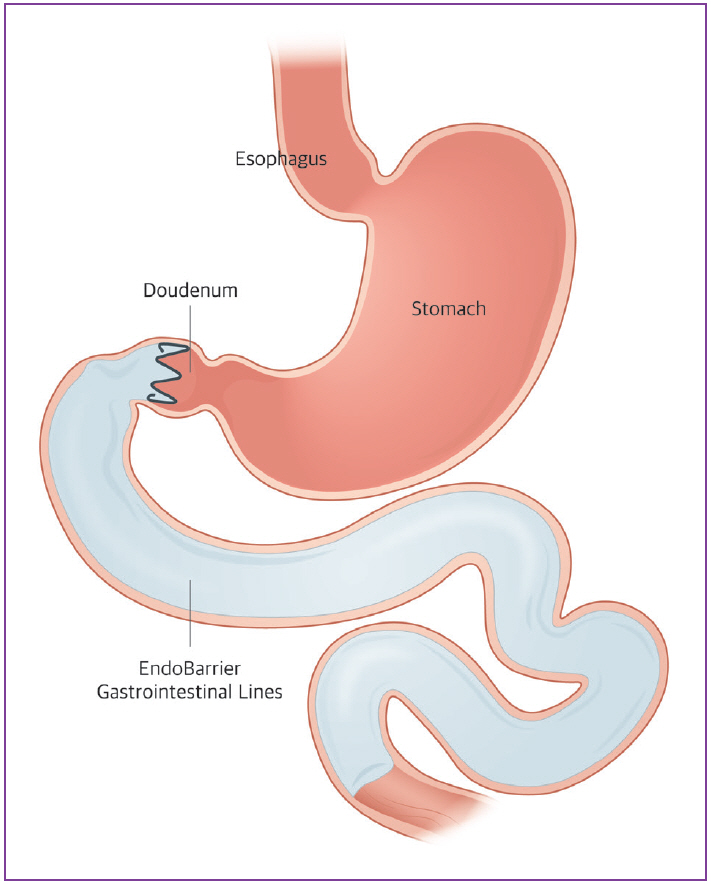Clin Endosc.
2017 Jan;50(1):26-30. 10.5946/ce.2017.004.
Role of Malabsorptive Endoscopic Procedures in Obesity Treatment
- Affiliations
-
- 1Division of Gastroenterology, Department of Internal Medicine, Seoul St. Mary’s Hospital, College of Medicine, The Catholic University of Korea, Seoul, Korea. parkjerry@catholic.ac.kr
- KMID: 2383487
- DOI: http://doi.org/10.5946/ce.2017.004
Abstract
- The incidence of obesity is increasing, and more definitive treatment modalities are needed. Endoluminal procedures, including restrictive endoscopic procedures, endoscopic gastroplasty, and malabsorptive endoscopic procedures, can reduce weight in obese patients and control obesity-related comorbidities. Malabsorptive endoscopic interventions also offer the potential for an ambulatory procedure that may be safer and more cost-effective compared with laparoscopic surgery. Malabsorptive endoscopic intervention can induce weight reduction and improve obesity-related metabolic parameters, despite complications such as device migration, obstruction, and abdominal pain. Improvement in technique will follow the development of new devices.
Keyword
MeSH Terms
Figure
Reference
-
1. Buchwald H, Avidor Y, Braunwald E, et al. Bariatric surgery: a systematic review and meta-analysis. JAMA. 2004; 292:1724–1737.
Article2. Thompson CC. Endoscopic therapy of obesity: a new paradigm in bariatric care. Gastrointest Endosc. 2010; 72:505–507.
Article3. Ellsmere JC, Thompson CC, Brugge WR, et al. Endoscopic interventions for weight loss surgery. Obesity (Silver Spring). 2009; 17:929–933.
Article4. Rodriguez-Grunert L, Galvao Neto MP, Alamo M, Ramos AC, Baez PB, Tarnoff M. First human experience with endoscopically delivered and retrieved duodenal-jejunal bypass sleeve. Surg Obes Relat Dis. 2008; 4:55–59.
Article5. Tarnoff M, Rodriguez L, Escalona A, et al. Open label, prospective, randomized controlled trial of an endoscopic duodenal-jejunal bypass sleeve versus low calorie diet for pre-operative weight loss in bariatric surgery. Surg Endosc. 2009; 23:650–656.
Article6. Schouten R, Rijs CS, Bouvy ND, et al. A multicenter, randomized efficacy study of the endobarrier gastrointestinal liner for presurgical weight loss prior to bariatric surgery. Ann Surg. 2010; 251:236–243.
Article7. Gersin KS, Rothstein RI, Rosenthal RJ, et al. Open-label, sham-controlled trial of an endoscopic duodenojejunal bypass liner for preoperative weight loss in bariatric surgery candidates. Gastrointest Endosc. 2010; 71:976–982.
Article8. de Moura EG, Martins BC, Lopes GS, et al. Metabolic improvements in obese type 2 diabetes subjects implanted for 1 year with an endoscopically deployed duodenal-jejunal bypass liner. Diabetes Technol Ther. 2012; 14:183–189.
Article9. Koehestanie P, de Jonge C, Berends FJ, Janssen IM, Bouvy ND, Greve JW. The effect of the endoscopic duodenal-jejunal bypass liner on obesity and type 2 diabetes mellitus, a multicenter randomized controlled trial. Ann Surg. 2014; 260:984–992.
Article10. Sandler BJ, Rumbaut R, Swain CP, et al. Human experience with an endoluminal, endoscopic, gastrojejunal bypass sleeve. Surg Endosc. 2011; 25:3028–3033.
Article11. Sandler BJ, Rumbaut R, Swain CP, et al. One-year human experience with a novel endoluminal, endoscopic gastric bypass sleeve for morbid obesity. Surg Endosc. 2015; 29:3298–3303.
Article



